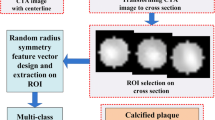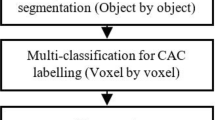Abstract
The identification of atherosclerotic plaque components, extraction and analysis of their morphology represent an important role towards the prediction of cardiovascular events. In this article, the classification of regions representing calcified components in computed tomography angiography (CTA) images of the carotid artery is tackled. The proposed classification model has two main steps: the classification per pixel and the classification per region. Features extracted from each pixel inside the carotid artery are submitted to four classifiers in order to determine the correct class, i.e. calcification or non-calcification. Then, geometrical and intensity features extracted from each candidate region resulting from the pixel classification step are submitted to the classification per region in order to determine the correct regions of calcified components. In order to evaluate the classification accuracy, the results of the proposed classification model were compared against ground truths of calcifications obtained from micro-computed tomography images of excised atherosclerotic plaques that were registered with in vivo CTA images. The average values of the Spearman correlation coefficient obtained by the linear discriminant classifier were higher than 0.80 for the relative volume of the calcified components. Moreover, the average values of the absolute error between the relative volumes of the classified calcium regions and the ones calculated from the corresponding ground truths were lower than 3%. The new classification model seems to be adequate as an auxiliary diagnostic tool for identifying calcifications and allowing their morphology assessment.













Similar content being viewed by others
References
Mendis S, Puska P, Norrving B (2011) Global atlas on cardiovascular disease prevention and control. World Health Organization, Geneva
Widder B, Paulat K, Hackspacher J, Hamann H, Hutschenreiter S, Kreutzer C, Ott F, Vollmar J (1990) Morphological characterization of carotid artery stenoses by ultrasound duplex scanning. Ultrasound Med Biol 16(4):349–354. https://doi.org/10.1016/0301-5629(90)90064-J
de Weert TT, Ouhlous M, Meijering E, Zondervan PE, Hendriks JM, van Sambeek MR, Dippel DW, van der Lugt A (2006) In vivo characterization and quantification of atherosclerotic carotid plaque components with multidetector computed tomography and histopathological correlation. Arterioscler Thromb Vasc Biol 26(10):2366–2372. https://doi.org/10.1161/01.ATV.0000240518.90124.57
Serfaty JM, Chaabane L, Tabib A, Chevallier JM, Briguet A, Douek PC (2001) Atherosclerotic plaques: classification and characterization with T2-weighted high-spatial-resolution MR imaging—an in vitro study. Radiology 219(2):403–410. https://doi.org/10.1148/radiology.219.2.r01ma15403
Fayad ZA, Fuster V (2000) Characterization of atherosclerotic plaques by magnetic resonance imaging. Ann N York Acad Sci 902:173–186. https://doi.org/10.1111/j.1749-6632.2000.tb06312.x
Seeger JM, Barratt E, Lawson GA, Klingman N (1995) The relationship between carotid plaque composition, plaque morphology, and neurologic symptoms. J Surg Res 58(3):330–336. https://doi.org/10.1006/jsre.1995.1051
Yuan C (2002) Identification of fibrous cap rupture with magnetic resonance imaging is highly associated with recent transient ischemic attack or stroke. Circulation 105(2):181–185. https://doi.org/10.1161/hc0202.102121
Redgrave JNE, Lovett JK, Gallagher PJ, Rothwell PM (2006) Histological assessment of 526 symptomatic carotid plaques in relation to the nature and timing of ischemic symptoms: the Oxford plaque study. Circulation 113(19):2320–2328. https://doi.org/10.1161/CIRCULATIONAHA.105.589044
Takaya N, Yuan C, Chu B, Saam T, Underbill H, Cai J, Tran N, Polissar NL, Isaac C, Ferguson MS, Garden GA, Cramer SC, Maravilla KR, Hashimoto B, Hatsukami TS (2006) Association between carotid plaque characteristics and subsequent ischemic cerebrovascular events: a prospective assessment with MRI—Initial results. Stroke 37(3):818–823. https://doi.org/10.1161/01.STR.0000204638.91099.91
Kwee RM, van Oostenbrugge RJ, Mess WH, Prins MH, van der Geest RJ, ter Berg JW, Franke CL, Korten AG, Meems BJ, van Engelshoven JM, Wildberger JE, Kooi ME (2013) MRI of carotid atherosclerosis to identify TIA and stroke patients who are at risk of a recurrence. J Magn Reson Imaging 37(5):1189–1194. https://doi.org/10.1002/jmri.23918
Salem MK, Bown MJ, Sayers RD, West K, Moore D, Nicolaides A, Robinson TG, Naylor AR (2014) Identification of patients with a histologically unstable carotid plaque using ultrasonic plaque image analysis. Eur J Vasc Endovasc Surg 48(2):118–125. https://doi.org/10.1016/j.ejvs.2014.05.015
Jodas DS, Pereira AS, Tavares JMRS (2016) A review of computational methods applied for identification and quantification of atherosclerotic plaques in images. Exp Syst Appl 46:1–14
Gentile C, Li S, Kar P, Karatzoglou A, Zappella G, Etrue E (2017) On context-dependent clustering of bandits. In: Proceedings of the 34th international conference on machine learning—Volume 70, JMLR.org, ICML’17, pp 1253–1262
Li S, Karatzoglou A, Gentile C (2016) Collaborative filtering bandits. In: Proceedings of the 39th international ACM SIGIR conference on research and development in information retrieval, ACM, New York, NY, USA, SIGIR ’16, pp 539–548. https://doi.org/10.1145/2911451.2911548
Korda N, Szörényi B, Li S (2016) Distributed clustering of linear bandits in peer to peer networks. In: Proceedings of the 33rd international conference on international conference on machine learning—Volume 48, JMLR.org, ICML’16, pp 1301–1309
Song L, Hsu W, Xu J, van der Schaar M (2016) Using contextual learning to improve diagnostic accuracy: application in breast cancer screening. IEEE J Biomed Health Inform 20(3):902–914. https://doi.org/10.1109/JBHI.2015.2414934
Gutiérrez B, Peter L, Klein T, Wachinger C (2017) A multi-armed bandit to smartly select a training set from big medical data. In: Descoteaux M, Maier-Hein L, Franz A, Jannin P, Collins DL, Duchesne S (eds) Medical Image computing and computer-assisted intervention MICCAI 2017. Springer International Publishing, Cham, pp 38–45
Kar P, Li S, Narasimhan H, Chawla S, Sebastiani F (2016) Online optimization methods for the quantification problem. In: Proceedings of the 22nd international conference on knowledge discovery and data mining, ACM, New York, NY, USA, KDD ’16, pp 1625–1634. https://doi.org/10.1145/2939672.2939832
Herbert C, Chandler A, Dinsmore R (1995) A definition of advanced types of atherosclerotic lesions and a histological classification of atherosclerosis. Circulation 92:1355–1374. https://doi.org/10.1161/01.CIR.92.5.1355
Huang H, Virmani R, Younis H, Burke AP, Kamm RD, Lee RT (2001) The impact of calcification on the biomechanical stability of atherosclerotic plaques. Circulation 103(8):1051–1056. https://doi.org/10.1161/01.CIR.103.8.1051
Vukadinovic D, van Walsum T, Manniesing R, Rozie S, Hameeteman R, de Weert TT, van der Lugt A, Niessen WJ (2010) Segmentation of the outer vessel wall of the common carotid artery in CTA. IEEE Trans Med Imaging 29(1):65–76. https://doi.org/10.1109/TMI.2009.2025702
van Engelen A, Niessen WJ, Klein S, Groen HC, Verhagen HJM, Wentzel JJ, van der Lugt A, de Bruijne M (2014) Atherosclerotic plaque component segmentation in combined carotid MRI and CTA data incorporating class label uncertainty. PLoS ONE 9(4):1–14. https://doi.org/10.1371/journal.pone.0094840
Wintermark M, Jawadi SS, Rapp JH, Tihan T, Tong E, Glidden DV, Abedin S, Schaeffer S, Acevedo-Bolton G, Boudignon B, Orwoll B, Pan X, Saloner D (2008) High-resolution CT imaging of carotid artery atherosclerotic plaques. Am J Neuroradiol 29(5):875–882. https://doi.org/10.3174/ajnr.A0950
de Graaf MA, Broersen A, Kitslaar PH, Roos CJ, Dijkstra J, Lelieveldt BPF, Jukema JW, Schalij MJ, Delgado V, Bax JJ, Reiber JHC, Scholte AJ (2013) Automatic quantification and characterization of coronary atherosclerosis with computed tomography coronary angiography: cross-correlation with intravascular ultrasound virtual histology. Int J Cardiovasc Imaging 29(5):1177–1190. https://doi.org/10.1007/s10554-013-0194-x
Yan H, Dai Y (2011) The comparison of five discriminant methods. In: International conference on management and service science, pp 1–4. https://doi.org/10.1109/ICMSS.2011.5999201
Van’t Klooster R, Naggara O, Marsico R, Reiber JHC, Meder JF, Van Der Geest RJ, Touzé E, Oppenheim C (2012) Automated versus manual in vivo segmentation of carotid plaque MRI. Am J Neuroradiol 33:1621–1627. https://doi.org/10.3174/ajnr.A3028
van Engelen A, Niessen WJ, Klein S, Groen HC, Verhagen HJM, Wentzel JJ, van der Lugt A, de Bruijne M (2012) Multi-feature-based plaque characterization in ex vivo MRI trained by registration to 3D histology. Phys Med Biol 57(1):241–256. https://doi.org/10.1088/0031-9155/57/1/241
van Engelen A, Niessen W, Klein S, Groen H, van Gaalen K, Verhagen H, Wentzel J, van der Lugt A, de Bruijne M (2013) Automated segmentation of atherosclerotic histology based on pattern classification. J Pathol Inform 4(2):1–7. https://doi.org/10.4103/2153-3539.109844
Vukadinovic D, Rozie S, Van Gils M, Van Walsum T, Manniesing R, Van Der Lugt A, Niessen WJ (2012) Automated versus manual segmentation of atherosclerotic carotid plaque volume and components in CTA: associations with cardiovascular risk factors. Int J Cardiovasc Imaging 28:877–887. https://doi.org/10.1007/s10554-011-9890-6
Acknowledgements
This work was partially funded by Coordenação de Aperfeiçoamento de Pessoal de Nível Superior (CAPES), a funding agency in Brazil, under the PhD Grant with reference number 0543/13-6. The authors thank the funding of Project NORTE-01-0145-FEDER-000022—SciTech—Science and Technology for Competitive and Sustainable Industries, co-financed by “Programa Operacional Regional do Norte” (NORTE2020), through “Fundo Europeu de Desenvolvimento Regional” (FEDER).
Author information
Authors and Affiliations
Corresponding author
Ethics declarations
Conflict of interest
The authors declare that they have no conflict of interest.
Additional information
Publisher's Note
Springer Nature remains neutral with regard to jurisdictional claims in published maps and institutional affiliations.
Rights and permissions
About this article
Cite this article
Jodas, D.S., Pereira, A.S. & Tavares, J.M.R.S. Classification of calcified regions in atherosclerotic lesions of the carotid artery in computed tomography angiography images. Neural Comput & Applic 32, 2553–2573 (2020). https://doi.org/10.1007/s00521-019-04183-z
Received:
Accepted:
Published:
Issue Date:
DOI: https://doi.org/10.1007/s00521-019-04183-z




